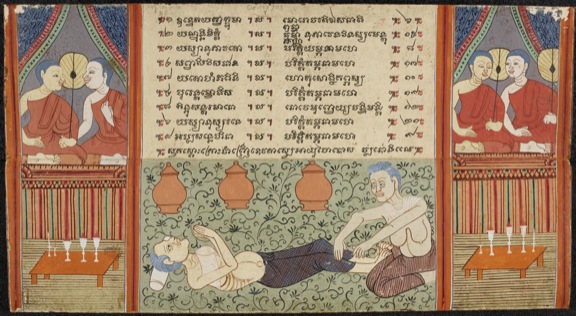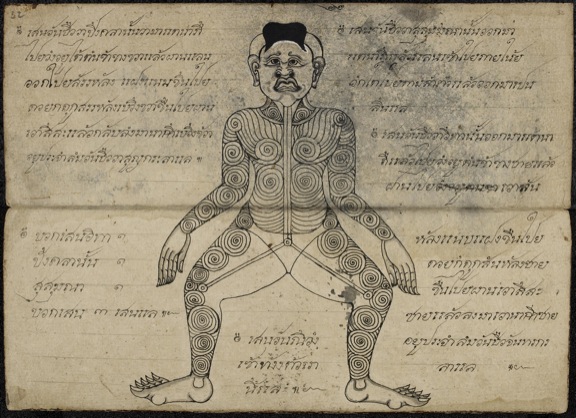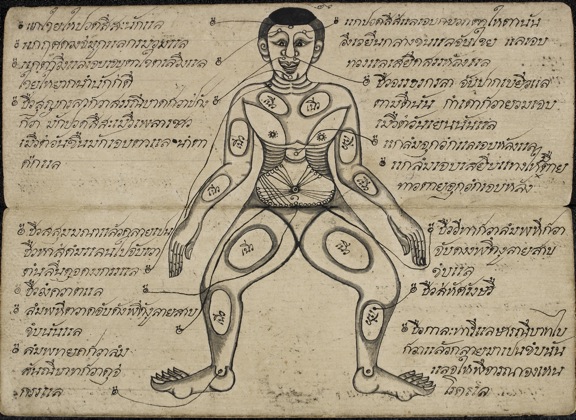Traditional
Thai medicine is a holistic discipline involving extensive use of indigenous
herbal and massage/pressure treatment combined with aspects of spirituality and
mental wellbeing. Having been influenced by Indian and Chinese concepts of
healing, traditional Thai medicine understands disease not as a physical matter
alone, but also as an imbalance of the patient with his social and spiritual
world.
Thai medical
manuscripts written during the 19th century give a broad overview of
different methods of treatment and prevention, of the understanding and
knowledge of the human body, mind/spirit and diseases. In
1831, King Rama III ordered the compilation of various medical treatises to be
used as teaching materials for the newly established royal medical schools at
Wat Phrachetuphon (Wat Pho) and Wat Ratcha-orot in Bangkok. Wat Phrachetuphon
formally became the first Royal School of Medicine in 1889 and still runs a Thai Traditional
Medical School today.
 This folding book, containing extracts from
the Vinaya Pitaka and the legend of Phra Malai (a monk who is believed to have travelled to heavens and hells
through the powers of meditation), depicts two elderly women, one
massaging the legs of the other woman lying down on the floor with her hands
folded in prayer. In the background earthenware vessels contain traditional
medicines, which were usually boiled in big pots and then taken throughout the
day (Or 13703, f. 81).
This folding book, containing extracts from
the Vinaya Pitaka and the legend of Phra Malai (a monk who is believed to have travelled to heavens and hells
through the powers of meditation), depicts two elderly women, one
massaging the legs of the other woman lying down on the floor with her hands
folded in prayer. In the background earthenware vessels contain traditional
medicines, which were usually boiled in big pots and then taken throughout the
day (Or 13703, f. 81).

Medical
manuals and handbooks (khamphi phaetsāt songkhro) describe the anatomy
and physiology of the human body, diseases and their possible causes, and methods
of diagnosis and treatment. Some of these books are finely illustrated with
human figures and diagrams; sometimes the human figures themselves appear like
diagrams, particularly in massage treatises (tamrā nūat). Other manuals
contain knowledge in the field of midwifery and herbalist practices including
recipes for the preparation and use of herbal medicines (tamrā yā samunphrai).
Most of these manuals were based on the knowledge and texts used by the royal
physicians at the Thai court. Thai traditional medicine can be traced back to
the Dvaravati (6th-13th centuries) and Sukhothai
(ca.1238-1438) kingdoms according to stone inscriptions and pharmaceutical
artefacts. Under King Narai (1656-1688), the first Thai pharmacopeia known as ‘Tamra Phra Osot Phra Narai’ was compiled
by royal physicians.
According
to the medical treatises, the human body consists of 42 elements, belonging
to four groups (earth, wind, water and fire). If one or several of these
elements are in disorder, it causes disease. The traditional Thai physician
would have to find out which elements were unbalanced and why, and then try to
restore the balance between them. This could be achieved by various methods,
which included treatment with herbal and other supporting natural remedies,
pressure points massage and body or head massage, as well as physical exercise
(Yoga), meditation and dieting – or a combination of several of these methods.
A
massage manual from Bangkok (Or 13922)

Or 13922, ff.
1-5

This
lavishly illustrated paper folding book (samut khoi) with black
lacquered covers is a manual for pressure massage in Thai language and script. It
describes the channels in the body terminating in pressure points and how
pressure massage can be used to treat certain illnesses. It is believed that
the book was produced at Wat Phrachetuphon, Bangkok, in the first half of
the 19th century as the text clearly relates to the medical
inscriptions from that time on the walls of this royal temple, which is
adjacent to the royal palace.
It begins with an unlabelled large gilded diagram of the human body (Or 13922, ff.
1-5, shown on the left). It gives an introductory overview of the network of
channels within the body. The figure is shown wearing lavish gilt royal
headgear and the main pressure points are also gilt, whereas the rest of the
body has been drawn in black ink. The area around the navel is a central point
where many channels start.
This manuscript can be viewed in full on our digitised
manuscripts webpage.
The diagram below (Or 13922, f. 32) indicates the channels and main pressure areas of the body,
stylistically represented by spiralling calligraphic lines. One channel known
as pinkhalā, for instance, begins at the navel and proceeds past the
base of the right leg to exit via the back. Another channel, the susumannā
line proceeds from the navel into the chest, climbs through the body and exits
through the tongue.

Or 13922, f. 32

In most
of the diagrams, the pressure points are named and their functions are
described in detail. The fleshy areas of the body are all neatly labelled as
such, so that the book also gives insight into the Thai understanding of the
human anatomy. Each illustration indicates the points of the body that can be
treated with pressure massage, which diseases can be treated and how many times
certain points have to be massaged.
 Here the pressure point above the right eye is identified as the one for
treating pains and infections of the eye as well as dizziness. In the middle of
the forehead is a point for treating headaches, fevers and congestion of mucus
and haemorrhage in the nasal passage. (Or 13922, f. 36)
Here the pressure point above the right eye is identified as the one for
treating pains and infections of the eye as well as dizziness. In the middle of
the forehead is a point for treating headaches, fevers and congestion of mucus
and haemorrhage in the nasal passage. (Or 13922, f. 36)

Massage in traditional Thai society
Not only massage treatises, but also
illustrated Buddhist manuscripts and literary texts provide evidence that massage
treatments were very popular and frequently used at all levels of Thai society. Buddhist manuscripts, such as the first example above, often contain genre scenes from the everyday
life of Buddhist monks and lay people.
Lively descriptions of situations where
pressure massage was carried out can be found in one of the most notable Thai
literary works, Khun Chang Khun Phaen, a lengthy narrative of love and
death which began in a folk tradition of oral performance (sēphā), but
was adopted by the royal court and transformed into written text in the early
19th century. Quite often, it seems, pressure massage was the method
of first choice in emergencies such as this (Chris Baker and Pasuk Phongpaichit (eds.),
The tale of Khun Chang Khun Phaen. Siam’s great folk epic of love and war. Chiang Mai, 2010, p. 236):
Her body
was motionless. ‘Wanthong, oh Wanthong!’ No sound came in return. With body
trembling, she shouted, ‘Servants! Come to help, quick!’ The servants all came
up in a rush. They propped Wanthong up. They wept. They massaged both her legs.
They pressed between her eyebrows to open her eyes. Siprajan cried out,
‘Softly, now! Why don’t you massage her jaw?’ She sat with a kaffir lime in her
hand, staring vacantly. ‘Do everything you can, everything.’ Someone bit
Wanthong’s big toe, and then she murmured.
Jana Igunma, Asia and African Studies

Follow us on Twitter @BLAsia_Africa
John Falconer
Mughals exhibition, Queen's Palace, Babur's Gardens, Kabul
John Falconer
John Falconer
John Falconer